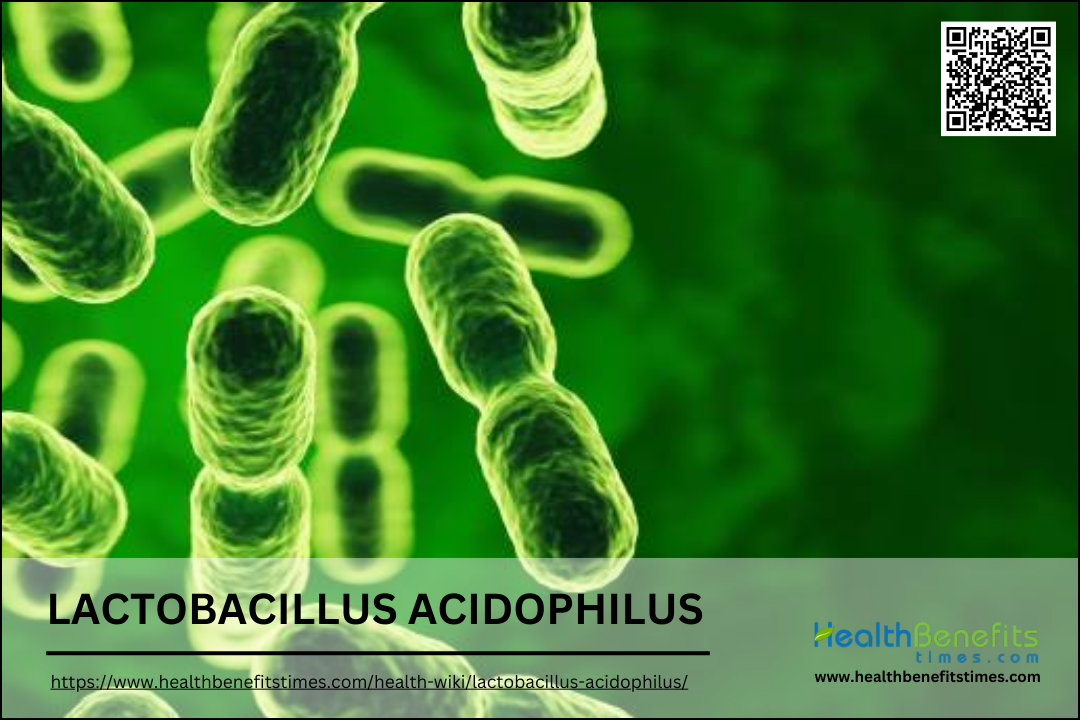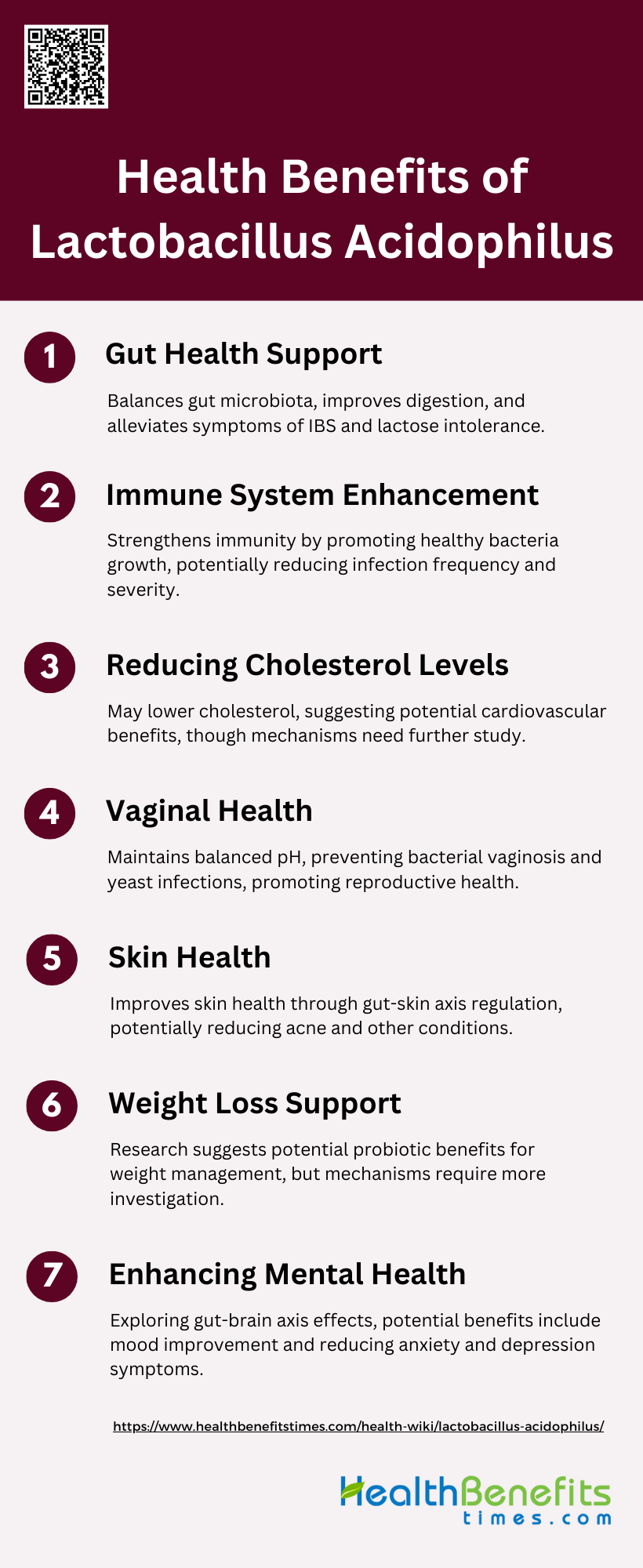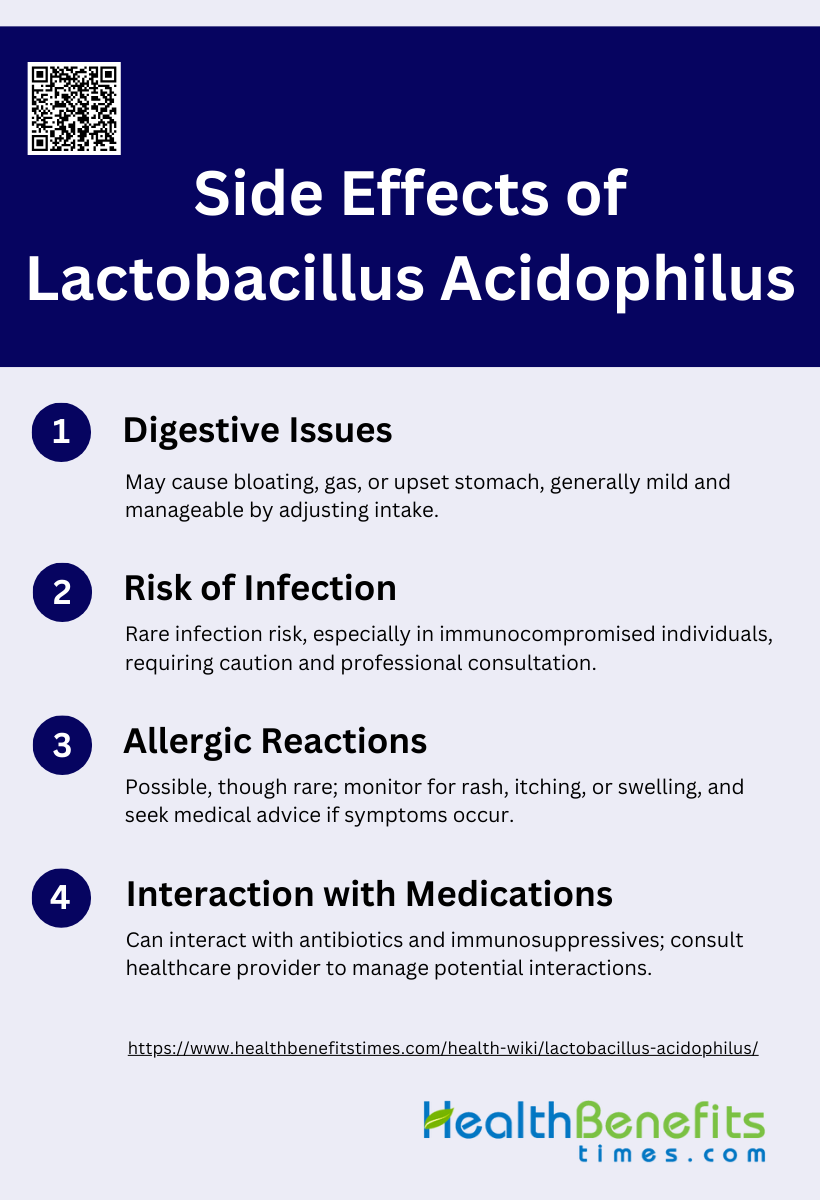Lactobacillus acidophilus is a Gram-positive lactic acid bacterium widely recognized for its probiotic properties and historical use in the dairy industry. It was originally isolated from the human gastrointestinal tract and has undergone multiple taxonomic revisions, now being a well-characterized species within the Lactobacillus genus. This bacterium is known for its ability to adhere to intestinal cells, produce antimicrobial compounds, and survive gastrointestinal transit, making it beneficial for human health. Studies have shown that L. acidophilus can modulate gut microbiota, enhance immune responses, and improve overall health in various organisms, including fish and crayfish. It has been found effective in reducing the duration and frequency of diarrhea in children with acute gastroenteritis and may aid in lactose digestion for lactose-intolerant individuals. The complete genome sequence of L. acidophilus NCFM has provided insights into its genetic makeup, revealing features that contribute to its probiotic functionality and interactions with the intestinal mucosa.
Natural sources of Lactobacillus Acidophilus
Lactobacillus acidophilus is a beneficial bacterium widely recognized for its role in promoting digestive health and supporting the immune system. It naturally resides in various parts of the human body and is also found in several fermented foods. Understanding the natural sources of L. acidophilus can help individuals incorporate this probiotic into their diet and lifestyle for improved health benefits.
A. Human Body
1. Gastrointestinal tract
Lactobacillus acidophilus is a prominent member of the gastrointestinal microbiota in humans. It plays a crucial role in maintaining gut health by balancing the intestinal flora and inhibiting the growth of harmful bacteria. This probiotic strain has been shown to survive gastrointestinal transit, adhering to the intestinal mucosa and producing antimicrobial compounds that help in reducing pathogenic bacteria. Additionally, it aids in the digestion of lactose, making it beneficial for individuals with lactose intolerance. The presence of L. acidophilus in the gut is associated with improved digestive health and enhanced immune response.
2. Oral cavity
Lactobacillus acidophilus is also found in the human oral cavity, where it contributes to oral health by inhibiting the growth of pathogenic bacteria that cause dental caries and periodontal diseases. Its probiotic properties help maintain a balanced oral microbiome, reducing the incidence of oral infections. The antimicrobial compounds produced by L. acidophilus can prevent the colonization of harmful bacteria, thereby promoting overall oral hygiene. Regular consumption of probiotics containing L. acidophilus can support oral health by maintaining a healthy balance of microorganisms in the mouth.
3. Vagina
In the vaginal microbiota, Lactobacillus acidophilus plays a vital role in maintaining a healthy environment by producing lactic acid, which lowers the pH and inhibits the growth of pathogenic bacteria and yeast. This probiotic strain helps prevent infections such as bacterial vaginosis and yeast infections by outcompeting harmful microorganisms and enhancing the natural defense mechanisms of the vaginal mucosa. The presence of L. acidophilus in the vagina is crucial for maintaining a balanced and healthy microbial ecosystem, which is essential for women’s reproductive health.
4. Urinary tract
Lactobacillus acidophilus is also present in the urinary tract, where it helps prevent urinary tract infections (UTIs) by inhibiting the growth of uropathogenic bacteria. The production of antimicrobial substances and the ability to adhere to the urinary tract lining make L. acidophilus an effective probiotic for maintaining urinary tract health. Regular intake of probiotics containing L. acidophilus can reduce the recurrence of UTIs and support the overall health of the urinary system by promoting a balanced microbial environment.
B. Food Sources
1. Yogurt
Yogurt is one of the most common food sources of Lactobacillus acidophilus. This probiotic is added to yogurt during the fermentation process, where it helps convert lactose into lactic acid, giving yogurt its characteristic tangy flavor. Consuming yogurt with L. acidophilus can improve gut health, enhance immune function, and aid in the digestion of lactose, making it a beneficial food for individuals with lactose intolerance. The regular intake of yogurt containing L. acidophilus can contribute to a healthy digestive system and overall well-being.
2. Kefir
Kefir, a fermented milk drink, is another excellent source of Lactobacillus acidophilus. This probiotic-rich beverage is made by fermenting milk with kefir grains, which contain a symbiotic culture of bacteria and yeast. L. acidophilus in kefir helps maintain a healthy gut microbiota, supports immune function, and improves digestion. The consumption of kefir can provide numerous health benefits, including enhanced gut health, reduced inflammation, and improved lactose digestion. Kefir is a versatile and nutritious option for incorporating probiotics into the diet.
3. Sauerkraut
Sauerkraut, a fermented cabbage dish, is a natural source of Lactobacillus acidophilus. The fermentation process involves the growth of lactic acid bacteria, including L. acidophilus, which helps preserve the cabbage and enhance its nutritional value. Consuming sauerkraut can support gut health by introducing beneficial probiotics that balance the intestinal microbiota and improve digestion. The presence of L. acidophilus in sauerkraut can also boost the immune system and reduce the risk of gastrointestinal infections. Sauerkraut is a flavorful and healthy addition to the diet.
4. Miso
Miso, a traditional Japanese fermented soybean paste, contains Lactobacillus acidophilus as part of its microbial community. The fermentation process involves the use of koji, a culture of Aspergillus oryzae, along with lactic acid bacteria like L. acidophilus. Miso is rich in probiotics, which can enhance gut health, improve digestion, and support immune function. Regular consumption of miso can provide a natural source of L. acidophilus, contributing to a balanced and healthy gut microbiota. Miso is a versatile ingredient that can be used in soups, marinades, and dressings.
5. Tempeh
Tempeh, a fermented soybean product, is another food source of Lactobacillus acidophilus. The fermentation process involves the growth of Rhizopus mold, along with beneficial bacteria like L. acidophilus. Tempeh is a nutritious and protein-rich food that supports gut health by providing probiotics that balance the intestinal microbiota and improve digestion. The presence of L. acidophilus in tempeh can also enhance immune function and reduce inflammation. Tempeh is a versatile and healthy addition to the diet, suitable for various culinary applications.
Health Benefits of Lactobacillus Acidophilus
Lactobacillus acidophilus is a probiotic bacterium with numerous health benefits, making it a valuable addition to one’s diet. Let’s explore its various positive effects on human health:
1. Gut Health Support
Lactobacillus acidophilus plays a crucial role in supporting gut health by helping to balance the gut microbiome. This probiotic strain enhances digestion and nutrient absorption, promoting overall digestive wellness. It may also alleviate symptoms of irritable bowel syndrome (IBS) and lactose intolerance, making it particularly beneficial for individuals with these conditions. By maintaining a healthy balance of gut bacteria, L. acidophilus contributes to improved digestive function and overall gastrointestinal health.
2. Immune System Enhancement
One of the significant benefits of Lactobacillus acidophilus is its ability to strengthen the immune system. By promoting the growth of healthy bacteria in the gut, L. acidophilus helps create a more robust defense against harmful pathogens. This probiotic strain exhibits antimicrobial properties, which can help prevent infections caused by harmful bacteria. Regular consumption of L. acidophilus-containing products may contribute to a more resilient immune system, potentially reducing the frequency and severity of various infections.
3. Reducing Cholesterol Levels
Studies have shown that Lactobacillus acidophilus has the potential to reduce cholesterol levels, which could have significant implications for cardiovascular health. In vitro research has demonstrated that various strains of L. acidophilus can reduce cholesterol levels in culture, with some strains showing up to 71% reduction in the presence of cholic acid. While the exact mechanisms may differ between in vitro and in vivo conditions, these findings suggest that L. acidophilus could play a role in managing cholesterol levels and potentially supporting heart health.
4. Vaginal Health
Lactobacillus acidophilus plays a crucial role in maintaining vaginal health. This probiotic strain helps prevent bacterial vaginosis and yeast infections by maintaining a balanced pH in the vaginal microbiome. L. acidophilus, along with other Lactobacillus species, can inhibit the growth of pathogenic bacteria responsible for urogenital infections. By promoting a healthy vaginal environment, L. acidophilus contributes to overall reproductive health and comfort for women.
5. Skin Health
While direct research on Lactobacillus acidophilus and skin health is limited, there is growing evidence supporting the connection between gut health and skin conditions. A balanced gut microbiome, which L. acidophilus helps maintain, may contribute to improved skin health. Some studies suggest that probiotics like L. acidophilus could potentially help reduce acne and other skin conditions by modulating the gut-skin axis. However, more research is needed to fully understand the specific effects of L. acidophilus on skin health.
6. Weight Loss Support
The potential role of probiotics like Lactobacillus acidophilus in weight management is an area of ongoing research. While some studies have explored the effects of probiotic supplementation on weight loss, the results are not conclusive for L. acidophilus specifically. More research is needed to determine the exact mechanisms and effectiveness of L. acidophilus in supporting weight loss. It’s important to note that probiotics should be considered as part of a comprehensive approach to weight management, including a balanced diet and regular exercise.
7. Enhancing Mental Health
The gut-brain axis, which connects the digestive system to the central nervous system, has been a subject of increasing interest in recent years. While research on Lactobacillus acidophilus and mental health is still in its early stages, some studies suggest that probiotics may have a positive impact on mental well-being. The potential of L. acidophilus to influence mood and reduce symptoms of anxiety and depression is an exciting area of research. However, more studies are needed to fully understand the mechanisms and extent of L. acidophilus’s effects on mental health.
Side Effects of Lactobacillus acidophilus
While Lactobacillus acidophilus is generally considered safe and beneficial for most people, it’s important to be aware of potential side effects. Understanding these side effects can help individuals make informed decisions about incorporating this probiotic into their routine. Here are some possible side effects of L. acidophilus to consider.
1. Digestive Issues
Lactobacillus acidophilus can cause digestive issues such as bloating, gas, or an upset stomach in some individuals. These side effects are generally mild and can be mitigated by adjusting the dosage and timing of intake. For instance, starting with a lower dose and gradually increasing it can help the body adjust to the probiotic. Additionally, taking L. acidophilus with meals may reduce gastrointestinal discomfort.
2. Risk of Infection
While rare, there have been cases where Lactobacillus acidophilus has caused infections, particularly in individuals with weakened immune systems. People with compromised immune systems, such as those undergoing chemotherapy or with chronic illnesses, should avoid taking L. acidophilus unless advised by a healthcare provider. This precaution helps prevent potential infections that could arise from probiotic use in vulnerable populations.
3. Allergic Reactions
Allergic reactions to Lactobacillus acidophilus are uncommon but possible. Symptoms to watch for include rash, itching, and swelling. If any of these symptoms occur, it is important to discontinue use and consult a healthcare provider immediately. Monitoring for these signs can help in early detection and management of allergic reactions.
4. Interaction with Medications
Lactobacillus acidophilus can interact with certain medications, particularly antibiotics and immunosuppressive drugs. These interactions can either reduce the effectiveness of the probiotic or the medication. Therefore, it is crucial to consult a healthcare provider before starting L. acidophilus, especially if you are on these medications. This ensures that any potential interactions are managed appropriately.
FAQs
1. How should Lactobacillus acidophilus supplements be stored?
Lactobacillus acidophilus supplements should typically be stored in a cool, dry place, and some forms may require refrigeration to maintain their potency. Always check the label for specific storage instructions.
2. Can Lactobacillus acidophilus be taken during pregnancy?
While Lactobacillus acidophilus is generally considered safe, pregnant women should consult their healthcare provider before starting any probiotic supplements to ensure it is suitable for their individual health needs.
3. Is Lactobacillus acidophilus safe for children?
Yes, Lactobacillus acidophilus is often used in children, especially for digestive issues like diarrhea. However, it is recommended to consult a pediatrician before giving probiotic supplements to a child.
4. Can I take Lactobacillus acidophilus daily, and for how long?
Yes, Lactobacillus acidophilus can be taken daily, but the duration of use may depend on individual health goals or conditions. Consult with a healthcare provider to determine how long you should continue taking it.
5. Does Lactobacillus acidophilus affect nutrient absorption?
Lactobacillus acidophilus may improve nutrient absorption, particularly aiding in the digestion of lactose and other nutrients by balancing gut flora. However, the impact on nutrient absorption varies among individuals.
6. Can Lactobacillus acidophilus help with food allergies?
Some research suggests that probiotics like Lactobacillus acidophilus may help reduce the severity of food allergies by modulating the immune system, but more studies are needed to confirm its effectiveness.
7. Are there vegan sources of Lactobacillus acidophilus?
Yes, Lactobacillus acidophilus can be found in certain plant-based fermented foods like sauerkraut, miso, and some probiotic supplements made without dairy.
8. Does Lactobacillus acidophilus affect oral microbiome health?
Yes, Lactobacillus acidophilus can contribute to a healthier oral microbiome by inhibiting the growth of harmful bacteria, which may reduce the risk of dental cavities and gum disease.
9. Can Lactobacillus acidophilus help with seasonal allergies?
While some studies suggest that probiotics may help alleviate symptoms of seasonal allergies, more research is needed to determine whether Lactobacillus acidophilus specifically offers benefits for allergy relief.
10. How does Lactobacillus acidophilus compare to other probiotics like Bifidobacterium?
Both Lactobacillus acidophilus and Bifidobacterium are beneficial probiotics, but they reside in different parts of the gut and may support different health functions. Lactobacillus acidophilus is more common in the small intestine, while Bifidobacterium is prevalent in the colon. Each may be more effective for different health issues.





